
- •CONTENTS
- •Preface
- •To the Student
- •Diagnostic Tests
- •1.1 Four Ways to Represent a Function
- •1.2 Mathematical Models: A Catalog of Essential Functions
- •1.3 New Functions from Old Functions
- •1.4 Graphing Calculators and Computers
- •1.6 Inverse Functions and Logarithms
- •Review
- •2.1 The Tangent and Velocity Problems
- •2.2 The Limit of a Function
- •2.3 Calculating Limits Using the Limit Laws
- •2.4 The Precise Definition of a Limit
- •2.5 Continuity
- •2.6 Limits at Infinity; Horizontal Asymptotes
- •2.7 Derivatives and Rates of Change
- •Review
- •3.2 The Product and Quotient Rules
- •3.3 Derivatives of Trigonometric Functions
- •3.4 The Chain Rule
- •3.5 Implicit Differentiation
- •3.6 Derivatives of Logarithmic Functions
- •3.7 Rates of Change in the Natural and Social Sciences
- •3.8 Exponential Growth and Decay
- •3.9 Related Rates
- •3.10 Linear Approximations and Differentials
- •3.11 Hyperbolic Functions
- •Review
- •4.1 Maximum and Minimum Values
- •4.2 The Mean Value Theorem
- •4.3 How Derivatives Affect the Shape of a Graph
- •4.5 Summary of Curve Sketching
- •4.7 Optimization Problems
- •Review
- •5 INTEGRALS
- •5.1 Areas and Distances
- •5.2 The Definite Integral
- •5.3 The Fundamental Theorem of Calculus
- •5.4 Indefinite Integrals and the Net Change Theorem
- •5.5 The Substitution Rule
- •6.1 Areas between Curves
- •6.2 Volumes
- •6.3 Volumes by Cylindrical Shells
- •6.4 Work
- •6.5 Average Value of a Function
- •Review
- •7.1 Integration by Parts
- •7.2 Trigonometric Integrals
- •7.3 Trigonometric Substitution
- •7.4 Integration of Rational Functions by Partial Fractions
- •7.5 Strategy for Integration
- •7.6 Integration Using Tables and Computer Algebra Systems
- •7.7 Approximate Integration
- •7.8 Improper Integrals
- •Review
- •8.1 Arc Length
- •8.2 Area of a Surface of Revolution
- •8.3 Applications to Physics and Engineering
- •8.4 Applications to Economics and Biology
- •8.5 Probability
- •Review
- •9.1 Modeling with Differential Equations
- •9.2 Direction Fields and Euler’s Method
- •9.3 Separable Equations
- •9.4 Models for Population Growth
- •9.5 Linear Equations
- •9.6 Predator-Prey Systems
- •Review
- •10.1 Curves Defined by Parametric Equations
- •10.2 Calculus with Parametric Curves
- •10.3 Polar Coordinates
- •10.4 Areas and Lengths in Polar Coordinates
- •10.5 Conic Sections
- •10.6 Conic Sections in Polar Coordinates
- •Review
- •11.1 Sequences
- •11.2 Series
- •11.3 The Integral Test and Estimates of Sums
- •11.4 The Comparison Tests
- •11.5 Alternating Series
- •11.6 Absolute Convergence and the Ratio and Root Tests
- •11.7 Strategy for Testing Series
- •11.8 Power Series
- •11.9 Representations of Functions as Power Series
- •11.10 Taylor and Maclaurin Series
- •11.11 Applications of Taylor Polynomials
- •Review
- •APPENDIXES
- •A Numbers, Inequalities, and Absolute Values
- •B Coordinate Geometry and Lines
- •E Sigma Notation
- •F Proofs of Theorems
- •G The Logarithm Defined as an Integral
- •INDEX

580 |||| CHAPTER 9 DIFFERENTIAL EQUATIONS
(c)Is there an equilibrium solution?
(d)If the initial charge is Q 0 0 C, use the direction field to sketch the solution curve.
(e)If the initial charge is Q 0 0 C, use Euler’s method with step size 0.1 to estimate the charge after half a second.
28.In Exercise 14 in Section 9.1 we considered a 95 C cup of coffee in a 20 C room. Suppose it is known that the coffee cools
at a rate of 1 C per minute when its temperature is 70 C.
(a)What does the differential equation become in this case?
(b)Sketch a direction field and use it to sketch the solution curve for the initial-value problem. What is the limiting value of the temperature?
(c)Use Euler’s method with step size h 2 minutes to estimate the temperature of the coffee after 10 minutes.
9.3SEPARABLE EQUATIONS
N The technique for solving separable differential equations was first used by James Bernoulli (in 1690) in solving a problem about pendulums and by Leibniz (in a letter to Huygens in 1691).
John Bernoulli explained the general method in a paper published in 1694.
We have looked at first-order differential equations from a geometric point of view (direction fields) and from a numerical point of view (Euler’s method). What about the symbolic point of view? It would be nice to have an explicit formula for a solution of a differential equation. Unfortunately, that is not always possible. But in this section we examine a certain type of differential equation that can be solved explicitly.
A separable equation is a first-order differential equation in which the expression for dy dx can be factored as a function of x times a function of y. In other words, it can be written in the form
dy t x f y dx
The name separable comes from the fact that the expression on the right side can be “separated” into a function of x and a function of y. Equivalently, if f y 0, we could write
1 |
dy |
|
t x |
|
dx |
h y |
|||
|
|
where h y 1 f y . To solve this equation we rewrite it in the differential form
h y dy t x dx
so that all y’s are on one side of the equation and all x’s are on the other side. Then we integrate both sides of the equation:
2 |
yh y dy yt x dx |
Equation 2 defines y implicitly as a function of x. In some cases we may be able to solve for y in terms of x.
We use the Chain Rule to justify this procedure: If h and t satisfy (2), then
|
|
|
d |
yh y dy |
d |
yt x dx |
||||
|
|
|
dx |
dx |
||||||
so |
d |
yh y dy |
dy |
t x |
||||||
dy |
dx |
|||||||||
and |
|
|
|
h y |
dy |
t x |
||||
|
|
|||||||||
|
|
|
|
|
|
dx |
||||
Thus Equation 1 is satisfied.
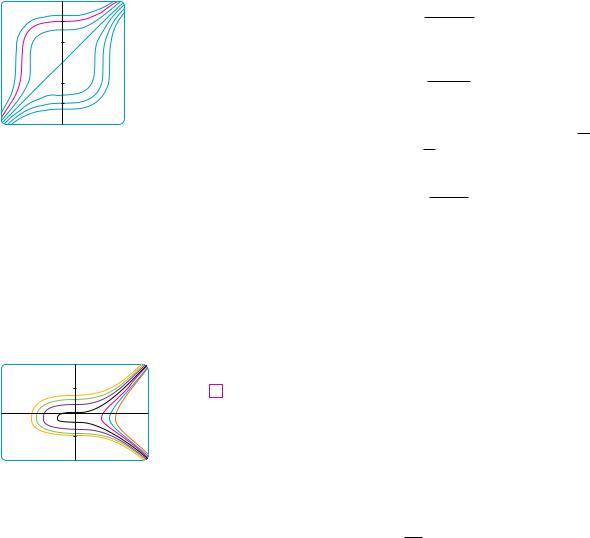
N Figure 1 shows graphs of several members of the family of solutions of the differential
equation in Example 1. The solution of the initialvalue problem in part (b) is shown in red.
3
_3  3
3
_3
FIGURE 1
N Some computer algebra systems can plot curves defined by implicit equations. Figure 2 shows the graphs of several members of the family of solutions of the differential equation in Example 2. As we look at the curves from left to right, the values of C are 3, 2, 1, 0, 1, 2, and 3.
4
_2 |
2 |
_4
FIGURE 2
|
|
|
|
SECTION 9.3 SEPARABLE EQUATIONS |||| 581 |
|
EXAMPLE 1 |
|
|
|
|
|
|
|
dy |
|
x2 |
|
(a) |
Solve the differential equation |
|
|
|
. |
dx |
y2 |
||||
(b) |
Find the solution of this equation that satisfies the initial condition y 0 2. |
||||
SOLUTION
(a) We write the equation in terms of differentials and integrate both sides:
y2 dy x2 dx
yy2 dy y x2 dx
13 y3 13 x3 C
where C is an arbitrary constant. (We could have used a constant C1 on the left side and another constant C2 on the right side. But then we could combine these constants by writing C C2 C1.)
Solving for y, we get
y s3 x3 3C
We could leave the solution like this or we could write it in the form
y s3 x3 K
where K 3C. (Since C is an arbitrary constant, so is K.)
(b) If we put x 0 in the general solution in part (a), we get y 0 s3 K . To satisfy the initial condition y 0 2, we must have s3 K 2 and so K 8.
Thus the solution of the initial-value problem is
|
|
3 |
8 |
|
|
M |
|
|
|
y sx3 |
|
|
|||
|
|
|
dy |
|
6x2 |
|
|
V |
EXAMPLE 2 Solve the differential equation |
|
|
|
. |
|
|
|
|
|
|||||
|
|
|
dx |
|
2y cos y |
|
|
SOLUTION |
Writing the equation in differential form and integrating both sides, we have |
|
|||||
|
|
2y cos y dy 6x2 dx |
|
||||
|
|
y 2y cos y dy y6x2 dx |
|
||||
3 |
y2 sin y 2x3 C |
|
|||||
where C is a constant. Equation 3 gives the general solution implicitly. In this case it’s |
|
||||||
impossible to solve the equation to express y explicitly as a function of x. |
M |
||||||
EXAMPLE 3 Solve the equation y x2 y.
SOLUTION First we rewrite the equation using Leibniz notation:
dy x2 y
dx
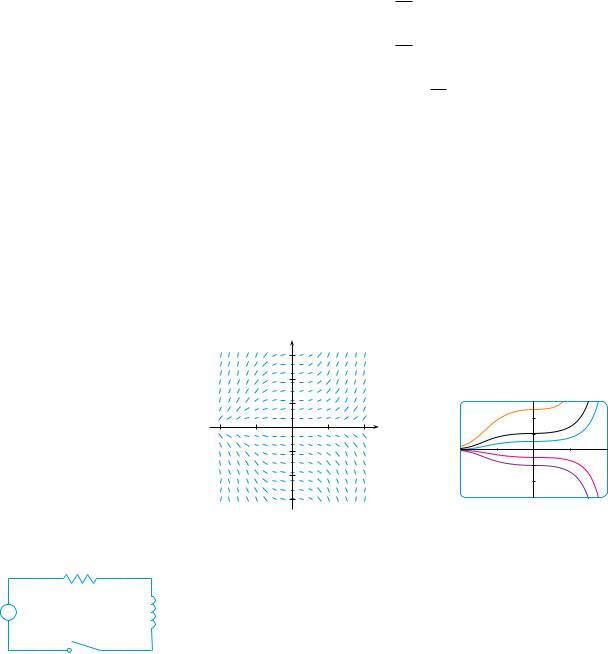
582 |||| CHAPTER 9 DIFFERENTIAL EQUATIONS
N If a solution y is a function that satisfies y x 0 for some x, it follows from a
uniqueness theorem for solutions of differential equations that y x 0 for all x.
If y 0, we can rewrite it in differential notation and integrate:
dy x2 dx y 0 y
y dyy yx2 dx
ln y x3 C
3
This equation defines y implicitly as a function of x. But in this case we can solve explicitly for y as follows:
y eln y e x3 3 C eCex3 3
so |
y eCex3 3 |
N Figure 3 shows a direction field for the differential equation in Example 3. Compare it with Figure 4, in which we use the equation
y Ae x 3 3 to graph solutions for several values of A. If you use the direction field to sketch solution curves with y-intercepts 5, 2, 1, 1, and 2, they will resemble the curves in
Figure 4.
We can easily verify that the function y 0 is also a solution of the given differential equation. So we can write the general solution in the form
|
|
|
y Aex 3 3 |
|
where A is an arbitrary constant (A eC, or A eC, or A 0). |
M |
|||
|
y |
|
|
|
|
6 |
|
|
|
|
4 |
|
|
|
|
2 |
|
6 |
|
|
|
|
|
|
_2 |
_1 0 |
1 |
2 x |
|
|
_2 |
|
_2 |
2 |
|
_4 |
|
|
|
|
_6 |
|
_6 |
|
|
|
|
|
|
FIGURE 3 FIGURE 4
|
R |
|
EXAMPLE 4 In Section 9.2 we modeled the current I t in the electric circuit shown in |
||||||
|
V |
||||||||
|
|
Figure 5 by the differential equation |
|
|
|
||||
E |
L |
|
|
|
L dI RI E t |
||||
|
|
|
|
|
|
|
|
|
|
|
|
|
|
|
|
|
|
|
|
|
|
|
|
|
|
dt |
|
|
|
|
switch |
Find an expression for the current in a circuit where the resistance is 12 , the induc- |
|||||||
FIGURE 5 |
|
tance is 4 H, a battery gives a constant voltage of 60 V, and the switch is turned on when |
|||||||
|
t 0. What is the limiting value of the current? |
|
|
||||||
|
|
|
|
||||||
|
|
SOLUTION With L 4, R 12, and E t 60, the equation becomes |
|||||||
|
|
4 |
dI |
12I 60 |
or |
dI |
15 3I |
||
|
|
|
|
||||||
dt |
dt |
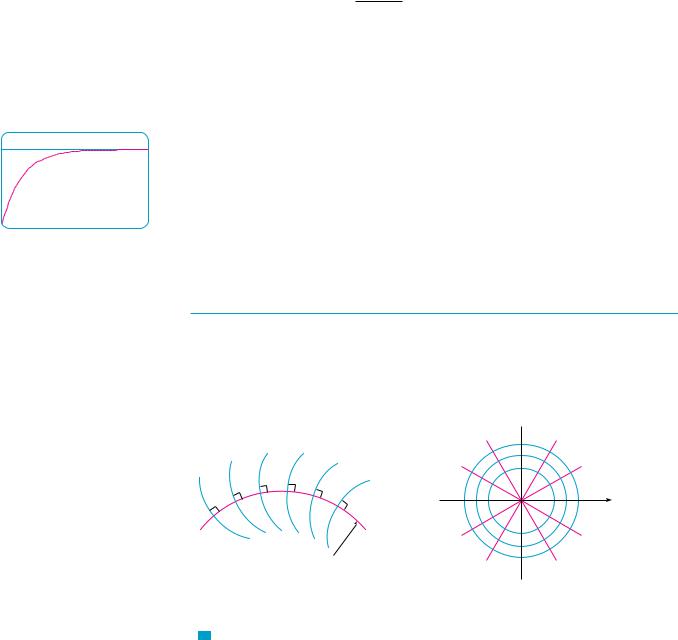
N Figure 6 shows how the solution in Example 4 (the current) approaches its limiting value. Comparison with Figure 11 in Section 9.2 shows that we were able to draw a fairly accurate solution curve from the direction field.
6
y=5
0 |
2.5 |
|
FIGURE 6
SECTION 9.3 SEPARABLE EQUATIONS |||| 583
and the initial-value problem is |
|
||
|
dI |
15 3I |
I 0 0 |
|
|
||
|
dt |
|
|
We recognize this equation as being separable, and we solve it as follows:
dI
y 15 3I
13 ln 15 3I t C
15 3I e 3 t C
15 3I e 3Ce 3t Ae 3t
I 5 13 Ae 3t
Since I 0 0, we have 5 13 A 0, so A 15 and the solution is
I t 5 5e 3t
The limiting current, in amperes, is
lim I t lim 5 5e 3t 5 5 lim e 3t 5 0 5 |
M |
||
t l |
t l |
t l |
|
ORTHOGONAL TRA JECTORIES
An orthogonal trajectory of a family of curves is a curve that intersects each curve of the family orthogonally, that is, at right angles (see Figure 7). For instance, each member of the family y mx of straight lines through the origin is an orthogonal trajectory of the family x2 y2 r2 of concentric circles with center the origin (see Figure 8). We say that the two families are orthogonal trajectories of each other.
y
x
|
orthogonal |
|
trajectory |
FIGURE 7 |
FIGURE 8 |
V EXAMPLE 5 Find the orthogonal trajectories of the family of curves x ky2, where k is an arbitrary constant.
SOLUTION The curves x ky2 form a family of parabolas whose axis of symmetry is the x-axis. The first step is to find a single differential equation that is satisfied by all
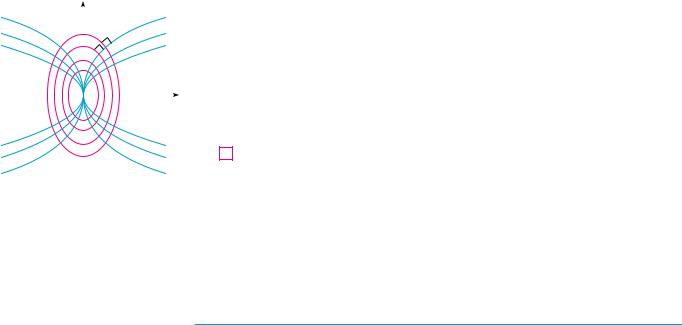
584 |||| CHAPTER 9 DIFFERENTIAL EQUATIONS
members of the family. If we differentiate x ky2, we get
1 2ky |
dy |
or |
dy |
|
1 |
|
dx |
dx |
2ky |
||||
|
|
|
This differential equation depends on k, but we need an equation that is valid for all values of k simultaneously. To eliminate k we note that, from the equation of the given general parabola x ky2, we have k x y2 and so the differential equation can be written as
|
|
dy |
|
|
1 |
|
|
|
1 |
|
|
|
|
|
|
2ky |
|
x |
|||||
|
|
dx |
2 |
||||||||
|
|
|
|
|
|
|
|
|
y |
||
|
|
|
|
|
|
|
|
y2 |
|||
or |
dy |
|
y |
|
|
|
|
|
|||
|
|
2x |
|
|
|
|
|||||
|
|
dx |
|
|
|
|
|||||
This means that the slope of the tangent line at any point x, y on one of the parabolas is y y 2x . On an orthogonal trajectory the slope of the tangent line must be the negative reciprocal of this slope. Therefore the orthogonal trajectories must satisfy the differential equation
y |
|
|
|
|
|
|
|
dy |
|
2x |
|
|
||||
|
|
|
|
|
dx |
|
y |
|
||||||||
|
|
|
|
|
|
|
|
|
|
|
|
|
||||
|
|
|
|
This differential equation is separable, and we solve it as follows: |
|
|||||||||||
|
|
|
|
|
|
yy dy y2x dx |
|
|||||||||
|
|
|
|
|
|
|
|
|
y |
2 |
|
|
|
|
|
|
|
|
x |
|
|
|
|
|
|
x2 C |
|
||||||
|
|
|
|
|
|
|
|
|
|
|
|
|
|
|||
|
|
|
|
|
|
|
|
2 |
|
|
|
|
||||
|
|
|
|
|
|
|
|
|
|
|
|
|
|
|
||
|
|
|
|
4 |
x2 |
|
|
y |
2 |
|
C |
|
||||
|
|
|
|
2 |
|
|
|
|||||||||
|
|
|
|
|
|
|
|
|
|
|
|
|
|
|||
|
|
|
|
where C is an arbitrary positive constant. Thus the orthogonal trajectories are the family |
||||||||||||
|
|
|
|
|||||||||||||
FIGURE 9 |
of ellipses given by Equation 4 and sketched in Figure 9. |
M |
||||||||||||||
Orthogonal trajectories occur in various branches of physics. For example, in an electrostatic field the lines of force are orthogonal to the lines of constant potential. Also, the streamlines in aerodynamics are orthogonal trajectories of the velocity-equipotential curves.
MIXING PROBLEMS
A typical mixing problem involves a tank of fixed capacity filled with a thoroughly mixed solution of some substance, such as salt. A solution of a given concentration enters the tank at a fixed rate and the mixture, thoroughly stirred, leaves at a fixed rate, which may differ from the entering rate. If y t denotes the amount of substance in the tank at time t, then y t is the rate at which the substance is being added minus the rate at which it is being removed. The mathematical description of this situation often leads to a first-order separable differential equation. We can use the same type of reasoning to model a variety of phenomena: chemical reactions, discharge of pollutants into a lake, injection of a drug into the bloodstream.
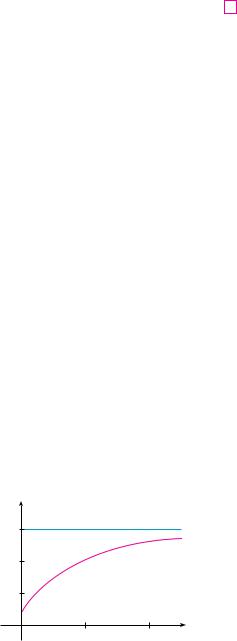
N Figure 10 shows the graph of the function y t of Example 6. Notice that, as time goes by, the amount of salt approaches 150 kg.
y |
|
|
|
150 |
|
|
|
100 |
|
|
|
50 |
|
|
|
0 |
200 |
400 |
t |
SECTION 9.3 SEPARABLE EQUATIONS |||| 585
EXAMPLE 6 A tank contains 20 kg of salt dissolved in 5000 L of water. Brine that contains 0.03 kg of salt per liter of water enters the tank at a rate of 25 L min. The solution is kept thoroughly mixed and drains from the tank at the same rate. How much salt remains in the tank after half an hour?
SOLUTION Let y t be the amount of salt (in kilograms) after t minutes. We are given that y 0 20 and we want to find y 30 . We do this by finding a differential equation satisfied by y t . Note that dy dt is the rate of change of the amount of salt, so
5 |
dy |
rate in rate out |
|
||
|
dt |
|
where (rate in) is the rate at which salt enters the tank and (rate out) is the rate at which salt leaves the tank. We have
|
|
|
L |
|
min |
|
min |
||
rate in |
|
0.03 |
kg |
|
25 |
L |
|
0.75 |
kg |
|
|
|
|
||||||
The tank always contains 5000 L of liquid, so the concentration at time t is y t 5000 (measured in kilograms per liter). Since the brine flows out at a rate of 25 L min, we have
rate out |
|
y t kg |
25 |
L |
|
|
y t |
|
kg |
|||||||||||||||
|
|
|
|
|
|
|
|
|
|
|
|
|
||||||||||||
5000 L |
min |
|
200 |
|
min |
|||||||||||||||||||
|
|
|
|
|
|
|
|
|
||||||||||||||||
Thus, from Equation 5, we get |
|
|
|
|
|
|
|
|
|
|
|
|
|
|
|
|
|
|
|
|
|
|
||
|
dy |
|
0.75 |
y t |
|
150 y t |
|
|
|
|||||||||||||||
|
dt |
|
|
|
|
|
|
|||||||||||||||||
|
200 |
|
|
|
|
|
|
|
|
200 |
|
|
|
|
||||||||||
Solving this separable differential equation, we obtain |
|
|
|
|
|
|||||||||||||||||||
|
|
|
|
y |
|
|
dy |
|
y |
dt |
|
|
|
|
|
|||||||||
|
|
|
150 y |
200 |
|
|
|
|
|
|||||||||||||||
|
|
ln 150 y |
|
|
|
t |
C |
|
|
|
|
|||||||||||||
|
|
|
|
|
|
|
|
|
|
|||||||||||||||
200 |
|
|
|
|
||||||||||||||||||||
Since y 0 20, we have ln 130 C, so |
|
|
|
|
|
|
|
|
|
|
|
|
|
|
||||||||||
|
ln 150 y |
|
|
t |
|
|
|
|
|
|
||||||||||||||
|
|
|
|
|
|
|
|
ln 130 |
|
|
||||||||||||||
|
200 |
|
|
|
||||||||||||||||||||
Therefore |
150 y 130e t 200 |
|
|
|
|
|||||||||||||||||||
Since y t is continuous and y 0 20 and the right side is never 0, we deduce that 150 y t is always positive. Thus 150 y 150 y and so
y t 150 130e t 200
The amount of salt after 30 min is
FIGURE 10 |
y 30 150 130e 30 200 38.1 kg |
M |

586 |||| CHAPTER 9 DIFFERENTIAL EQUATIONS
9.3EXERCISES
1–10 Solve the differential equation. |
|
|
|
|
|
|
|
|
|
|
|
|
|
|||||||||||
|
|
dy |
|
y |
|
|
|
|
|
dy |
|
s |
|
|
|
|||||||||
1. |
|
|
|
|
|
2. |
x |
|||||||||||||||||
|
x |
|
|
|
|
e y |
||||||||||||||||||
|
|
dx |
|
|
|
|
|
|
|
dx |
|
|
|
|
||||||||||
3. |
x 2 1 y xy |
4. |
y y 2 sin x |
|||||||||||||||||||||
|
|
|
|
|
|
|
du |
|
|
|
1 s |
|
|
|
||||||||||
5. |
1 tan y y x2 1 |
6. |
r |
|||||||||||||||||||||
|
|
|
|
|
|
|
|
|
||||||||||||||||
dr |
|
|
1 su |
|||||||||||||||||||||
|
|
|
|
|
|
|
|
|
|
|
|
|
|
|
|
|||||||||
7. |
|
dy |
|
|
|
|
|
te t |
8. |
dy |
|
|
|
|
e y sin2 |
|||||||||
|
|
|
|
|
|
|
|
|
|
|
|
|
|
|
|
|
|
|
|
|
||||
|
dt |
|
ys1 y2 |
d |
|
|
y sec |
|||||||||||||||||
|
|
|
|
|
|
|
|
|
|
|||||||||||||||
9. |
|
du |
|
2 2u t tu |
10. |
dz |
|
|
e t z 0 |
|||||||||||||||
|
dt |
dt |
||||||||||||||||||||||
|
|
|
|
|
|
|
|
|
|
|
|
|
|
|
|
|
|
|
|
|
|
|
||
|
|
|
|
|
|
|
|
|
|
|
|
|
|
|
|
|
|
|
|
|
|
|
|
|
11–18 Find the solution of the differential equation that satisfies the given initial condition.
11. |
dy |
|
x |
, y 0 3 |
||||||||||
|
|
|||||||||||||
|
dx |
|
|
|
|
y |
|
|
||||||
12. |
dy |
|
|
y cos x |
, |
y 0 1 |
||||||||
|
|
|
|
|||||||||||
|
dx |
|
|
|
|
1 y 2 |
|
|
||||||
13. |
x cos x 2y e 3y y , y 0 0 |
|||||||||||||
|
dP |
|
|
|
|
|
|
|
|
|
|
|
||
14. |
|
sPt , |
P 1 2 |
|||||||||||
|
|
|
|
|||||||||||
dt |
|
|||||||||||||
|
du |
|
|
|
|
2t sec2t |
||||||||
15. |
|
|
|
|
|
|
|
|
|
|
|
, u 0 5 |
||
dt |
|
|
2u |
|
||||||||||
|
|
|
|
|
|
|
|
|
||||||
16. |
x y y y 2, |
y 1 1 |
||||||||||||
17. |
y tan x a y, y 3 a, 0 x 2 |
|||||||||||||
18.dL kL2 ln t, L 1 1 dt
19.Find an equation of the curve that passes through the point0, 1 and whose slope at x, y is xy.
20. Find the function f such that f x f x 1 f x and f 0 12.
21.Solve the differential equation y x y by making the change of variable u x y.
22.Solve the differential equation xy y xe y x by making the change of variable v y x.
23.(a) Solve the differential equation y 2x s1 y 2 .
|
|
|
|
|
; |
(b) Solve the initial-value problem y 2x s1 y 2 , |
|||
|
y 0 0, and graph the solution. |
|||
|
(c) Does the initial-value problem y 2x s |
1 y 2 |
, |
|
|
y 0 2, have a solution? Explain. |
|||
;24. Solve the equation e yy cos x 0 and graph several members of the family of solutions. How does the solution curve change as the constant C varies?
CAS 
 25. Solve the initial-value problem y sin x sin y,
25. Solve the initial-value problem y sin x sin y,
y 0 2, and graph the solution (if your CAS does implicit plots).
CAS 26. Solve the equation y x sx2 1 ye y and graph several members of the family of solutions (if your CAS does implicit plots). How does the solution curve change as the constant C varies?
CAS 27–28
(a)Use a computer algebra system to draw a direction field for the differential equation. Get a printout and use it to sketch some solution curves without solving the differential equation.
(b)Solve the differential equation.
(c)Use the CAS to draw several members of the family of solutions obtained in part (b). Compare with the curves from part (a).
27. y 1 y |
28. y x 2 y |
|
|
;29–32 Find the orthogonal trajectories of the family of curves. Use a graphing device to draw several members of each family on a common screen.
29. |
x 2 2y 2 k 2 |
30. |
y 2 kx 3 |
||||
31. |
y |
k |
32. |
y |
x |
||
|
|
|
|
||||
x |
1 kx |
||||||
|
|
|
|
|
|
|
|
33.Solve the initial-value problem in Exercise 27 in Section 9.2 to find an expression for the charge at time t. Find the limiting value of the charge.
34.In Exercise 28 in Section 9.2 we discussed a differential equation that models the temperature of a 95 C cup of coffee in a 20 C room. Solve the differential equation to find an expression for the temperature of the coffee at time t.
35.In Exercise 13 in Section 9.1 we formulated a model for learning in the form of the differential equation
dP k M P dt
where P t measures the performance of someone learning a skill after a training time t, M is the maximum level of performance, and k is a positive constant. Solve this differential equation to find an expression for P t . What is the limit of this expression?

36.In an elementary chemical reaction, single molecules of two reactants A and B form a molecule of the product C: A B l C. The law of mass action states that the rate of reaction is proportional to the product of the concentrations of A and B:
d C k A B dt
(See Example 4 in Section 3.7.) Thus, if the initial concentrations are A a moles L and B b moles L and we write x C , then we have
dx k a x b x dt
CAS (a) Assuming that a b, find x as a function of t. Use the fact that the initial concentration of C is 0.
(b) Find x t assuming that a b. How does this expression for x t simplify if it is known that C 12 a after
20seconds?
37.In contrast to the situation of Exercise 36, experiments show that the reaction H2 Br2 l 2HBr satisfies the rate law
d HBr k H 2 Br2 1 2 dt
and so for this reaction the differential equation becomes
dx k a x b x 1 2 dt
where x HBr and a and b are the initial concentrations of hydrogen and bromine.
(a)Find x as a function of t in the case where a b. Use the fact that x 0 0.
(b)If a b, find t as a function of x. [Hint: In performing the integration, make the substitution u sb x .]
38.A sphere with radius 1 m has temperature 15 C. It lies inside
a concentric sphere with radius 2 m and temperature 25 C. The temperature T r at a distance r from the common center of the spheres satisfies the differential equation
d 2T |
2 |
|
dT |
0 |
|
|
|
|
|
|
|
dr 2 |
r |
|
dr |
||
If we let S dT dr, then S satisfies a first-order differential equation. Solve it to find an expression for the temperature T r between the spheres.
39.A glucose solution is administered intravenously into the bloodstream at a constant rate r. As the glucose is added, it is converted into other substances and removed from the blood-
stream at a rate that is proportional to the concentration at that time. Thus a model for the concentration C C t of the glucose solution in the bloodstream is
dC r kC dt
where k is a positive constant.
SECTION 9.3 SEPARABLE EQUATIONS |||| 587
(a)Suppose that the concentration at time t 0 is C0. Determine the concentration at any time t by solving the differential equation.
(b)Assuming that C0 r k, find lim t l C t and interpret your answer.
40.A certain small country has $10 billion in paper currency in circulation, and each day $50 million comes into the country’s banks. The government decides to introduce new
currency by having the banks replace old bills with new ones whenever old currency comes into the banks. Let x x t
denote the amount of new currency in circulation at time t, with x 0 0.
(a)Formulate a mathematical model in the form of an initial-value problem that represents the “flow” of the new currency into circulation.
(b)Solve the initial-value problem found in part (a).
(c)How long will it take for the new bills to account for 90% of the currency in circulation?
41.A tank contains 1000 L of brine with 15 kg of dissolved salt. Pure water enters the tank at a rate of 10 L min. The solution is kept thoroughly mixed and drains from the tank at the same rate. How much salt is in the tank (a) after t minutes and
(b)after 20 minutes?
42.The air in a room with volume 180 m3 contains 0.15% carbon
dioxide initially. Fresher air with only 0.05% carbon dioxide flows into the room at a rate of 2 m3 min and the mixed air flows out at the same rate. Find the percentage of carbon dioxide in the room as a function of time. What happens in the long run?
43.A vat with 500 gallons of beer contains 4% alcohol (by
volume). Beer with 6% alcohol is pumped into the vat at a rate of 5 gal min and the mixture is pumped out at the same rate. What is the percentage of alcohol after an hour?
44.A tank contains 1000 L of pure water. Brine that contains
0.05 kg of salt per liter of water enters the tank at a rate of
5 L min. Brine that contains 0.04 kg of salt per liter of water enters the tank at a rate of 10 L min. The solution is kept
thoroughly mixed and drains from the tank at a rate of
15 L min. How much salt is in the tank (a) after t minutes and (b) after one hour?
45.When a raindrop falls, it increases in size and so its mass at time t is a function of t, m t . The rate of growth of the mass is km t for some positive constant k. When we apply Newton’s Law of Motion to the raindrop, we get mv tm, where v is the velocity of the raindrop (directed downward)
and t is the acceleration due to gravity. The terminal velocity of the raindrop is lim t l v t . Find an expression for the terminal velocity in terms of t and k.
46.An object of mass m is moving horizontally through a medium which resists the motion with a force that is a function of the velocity; that is,
m |
d 2s |
m |
dv |
f v |
dt 2 |
dt |

588 |||| CHAPTER 9 DIFFERENTIAL EQUATIONS
where v v t and s s t represent the velocity and position of the object at time t, respectively. For example, think of a boat moving through the water.
(a)Suppose that the resisting force is proportional to the velocity, that is, f v kv, k a positive constant.
(This model is appropriate for small values of v.) Let v 0 v0 and s 0 s0 be the initial values of v and s. Determine v and s at any time t. What is the total distance that the object travels from time t 0?
(b)For larger values of v a better model is obtained by sup-
posing that the resisting force is proportional to the square of the velocity, that is, f v kv2, k 0. (This model was first proposed by Newton.) Let v0 and s0 be the initial values of v and s. Determine v and s at any time t. What is the total distance that the object travels in this case?
47.Let A t be the area of a tissue culture at time t and let M be the final area of the tissue when growth is complete. Most
cell divisions occur on the periphery of the tissue and the number of cells on the periphery is proportional to sA t . So a reasonable model for the growth of tissue is obtained by
assuming that the rate of growth of the area is jointly proportional to sA t and M A t .
(a)Formulate a differential equation and use it to show that the tissue grows fastest when A t 13 M.
CAS (b) Solve the differential equation to find an expression for A t . Use a computer algebra system to perform the integration.
48.According to Newton’s Law of Universal Gravitation, the gravitational force on an object of mass m that has been projected vertically upward from the earth’s surface is
mtR 2 F x R 2
where x x t is the object’s distance above the surface at time t, R is the earth’s radius, and t is the acceleration due to gravity. Also, by Newton’s Second Law,
F ma m dv dt and so
m |
dv |
|
mtR 2 |
|
x R 2 |
||
|
dt |
||
(a) Suppose a rocket is fired vertically upward with an initial velocity v0. Let h be the maximum height above the surface reached by the object. Show that
v0
2tRh
R h
[Hint: By the Chain Rule, m dv dt mv dv dx .]
(b)Calculate ve lim h l v0. This limit is called the escape velocity for the earth.
(c)Use R 3960 mi and t 32 ft s2 to calculate ve in feet per second and in miles per second.
|
A P P L I E D |
HOW FAST DOES A TANK DRAIN? |
||||
|
P R O J E C T |
If water (or other liquid) drains from a tank, we expect that the flow will be greatest at first (when |
||||
|
|
|||||
|
|
|||||
|
|
the water depth is greatest) and will gradually decrease as the water level decreases. But we need |
||||
|
|
a more precise mathematical description of how the flow decreases in order to answer the kinds |
||||
|
|
of questions that engineers ask: How long does it take for a tank to drain completely? How much |
||||
|
|
water should a tank hold in order to guarantee a certain minimum water pressure for a sprinkler |
||||
|
|
system? |
|
|
|
|
|
|
Let h t and V t be the height and volume of water in a tank at time t. If water drains through a |
||||
|
|
hole with area a at the bottom of the tank, then Torricelli’s Law says that |
||||
|
|
|
dV |
a s |
|
|
|
|
1 |
2th |
|||
|
|
|
||||
|
|
|
dt |
|||
where t is the acceleration due to gravity. So the rate at which water flows from the tank is proportional to the square root of the water height.
1.(a) Suppose the tank is cylindrical with height 6 ft and radius 2 ft and the hole is circular with radius 1 inch. If we take t 32 ft s2, show that h satisfies the differential equation
dh 1 sh dt 72
(b)Solve this equation to find the height of the water at time t, assuming the tank is full at time t 0.
(c)How long will it take for the water to drain completely?

APPLIED PROJECT HOW FAST DOES A TANK DRAIN? |||| 589
N This part of the project is best done as a classroom demonstration or as a group project with three students in each group: a timekeeper to call out seconds, a bottle keeper to estimate the height every 10 seconds, and a record keeper to record these values.
2.Because of the rotation and viscosity of the liquid, the theoretical model given by Equation 1 isn’t quite accurate. Instead, the model
2 |
dh |
ks |
|
|
h |
||||
|
||||
|
dt |
|||
is often used and the constant k (which depends on the physical properties of the liquid) is determined from data concerning the draining of the tank.
(a)Suppose that a hole is drilled in the side of a cylindrical bottle and the height h of the
water (above the hole) decreases from 10 cm to 3 cm in 68 seconds. Use Equation 2 to find an expression for h t . Evaluate h t for t 10, 20, 30, 40, 50, 60.
(b)Drill a 4-mm hole near the bottom of the cylindrical part of a two-liter plastic soft-drink bottle. Attach a strip of masking tape marked in centimeters from 0 to 10, with 0 corre-
sponding to the top of the hole. With one finger over the hole, fill the bottle with water to the 10-cm mark. Then take your finger off the hole and record the values of h t for
t 10, 20, 30, 40, 50, 60 seconds. (You will probably find that it takes 68 seconds for the level to decrease to h 3 cm.) Compare your data with the values of h t from part (a). How well did the model predict the actual values?
3.In many parts of the world, the water for sprinkler systems in large hotels and hospitals is supplied by gravity from cylindrical tanks on or near the roofs of the buildings. Suppose
such a tank has radius 10 ft and the diameter of the outlet is 2.5 inches. An engineer has to guarantee that the water pressure will be at least 2160 lb ft 2 for a period of 10 minutes. (When a fire happens, the electrical system might fail and it could take up to 10 minutes for the emergency generator and fire pump to be activated.) What height should the engineer specify for the tank in order to make such a guarantee? (Use the fact that the water pressure at a depth of
d feet is P 62.5d. See Section 8.3.)
4.Not all water tanks are shaped like cylinders. Suppose a tank has cross-sectional area A h at
height h. Then the volume of water up to height h is V x0h A u du and so the Fundamental Theorem of Calculus gives dV dh A h . It follows that
dV |
|
dV |
|
dh |
A h |
dh |
dt |
dh |
|
dt |
|||
|
|
dt |
||||
and so Torricelli’s Law becomes
A h dh a s2th dt
(a)Suppose the tank has the shape of a sphere with radius 2 m and is initially half full of water. If the radius of the circular hole is 1 cm and we take t 10 m s2, show that h satisfies the differential equation
4h h2 dh 0.0001 s20h dt
(b) How long will it take for the water to drain completely?

590 |||| CHAPTER 9 DIFFERENTIAL EQUATIONS
|
A P P L I E D |
|
WHICH IS FASTER, GOING UP OR COMING DOWN? |
||||||||||||||||||||
|
P R O J E C T |
|
Suppose you throw a ball into the air. Do you think it takes longer to reach its maximum |
||||||||||||||||||||
|
|
|
|||||||||||||||||||||
|
|
|
|||||||||||||||||||||
|
|
|
height or to fall back to earth from its maximum height? We will solve the problem in this proj- |
||||||||||||||||||||
|
|
|
ect but, before getting started, think about that situation and make a guess based on your physical |
||||||||||||||||||||
|
|
|
intuition. |
|
|
|
|
|
|
|
|
|
|
|
|
|
|
|
|
|
|
|
|
|
|
|
1. A ball with mass m is projected vertically upward from the earth’s surface with a positive |
||||||||||||||||||||
|
|
|
initial velocity v0. We assume the forces acting on the ball are the force of gravity and a |
||||||||||||||||||||
|
|
|
retarding force of air resistance with direction opposite to the direction of motion and with |
||||||||||||||||||||
|
|
|
magnitude p v t , where p is a positive constant and v t is the velocity of the ball at time t. |
||||||||||||||||||||
N In modeling force due to air resistance, |
In both the ascent and the descent, the total force acting on the ball is pv mt. [During |
||||||||||||||||||||||
various functions have been used, depending |
ascent, v t is positive and the resistance acts downward; during descent, v t is negative and |
||||||||||||||||||||||
on the physical characteristics and speed of |
the resistance acts upward.] So, by Newton’s Second Law, the equation of motion is |
||||||||||||||||||||||
the ball. Here we use a linear model, pv, but |
|
|
|
|
|
|
|
|
|
|
|
|
|
|
|
|
|
|
|
|
|
||
a quadratic model ( pv 2 on the way up and |
|
|
|
mv pv mt |
|
|
|
|
|
||||||||||||||
pv2 on the way down) is another possibility for |
|
|
|
|
|
|
|
|
|||||||||||||||
higher speeds (see Exercise 46 in Section 9.3). |
Solve this differential equation to show that the velocity is |
||||||||||||||||||||||
For a golf ball, experiments have shown that a |
|
|
|
|
|
|
|
|
|
|
|
|
|
|
|
|
|
|
|
|
|||
good model is pv 1.3 going up and p v 1.3 |
v t |
|
|
|
|
mt |
|
e pt m |
mt |
|
|
|
|||||||||||
coming down. But no matter which force func- |
v0 |
|
|
||||||||||||||||||||
|
p |
||||||||||||||||||||||
tion f v is used [where f v 0 for v 0 |
|
|
|
|
|
|
|
|
p |
|
|
||||||||||||
and f v 0 for v 0], the answer to the |
2. Show that the height of the ball, until it hits the ground, is |
||||||||||||||||||||||
question remains the same. See F. Brauer, |
|||||||||||||||||||||||
“What Goes Up Must Come Down, Eventually,” |
|
|
|
|
|
|
p p |
|
|
|
|
p |
|||||||||||
Amer. Math. Monthly 108 (2001), pp. 437– 440. |
y t v0 |
mt |
|
|
m |
1 e pt m |
mtt |
|
|||||||||||||||
|
|
|
|
|
|
|
|
|
|||||||||||||||
|
|
|
3. Let t1 be the time that the ball takes to reach its maximum height. Show that |
||||||||||||||||||||
|
|
|
|
|
|
|
|
|
p |
|
mt |
mt |
|
||||||||||
|
|
|
|
|
t1 |
m |
|
ln |
|
|
|
pv0 |
|
|
|
|
|
||||||
|
|
|
|
|
|
|
|
|
|
|
|
|
|
|
|
|
|
||||||
Find this time for a ball with mass 1 kg and initial velocity 20 m s. Assume the air resistance is 101 of the speed.
;4. Let t2 be the time at which the ball falls back to earth. For the particular ball in Problem 3, estimate t2 by using a graph of the height function y t . Which is faster, going up or coming down?
5.In general, it’s not easy to find t2 because it’s impossible to solve the equation y t 0
explicitly. We can, however, use an indirect method to determine whether ascent or descent is faster; we determine whether y 2t1 is positive or negative. Show that
y 2t1 mp22t x 1x 2 ln x
where x ept1 m. Then show that x 1 and the function
f x x 1 2 ln x x
is increasing for x 1. Use this result to decide whether y 2t1 is positive or negative. What can you conclude? Is ascent or descent faster?
